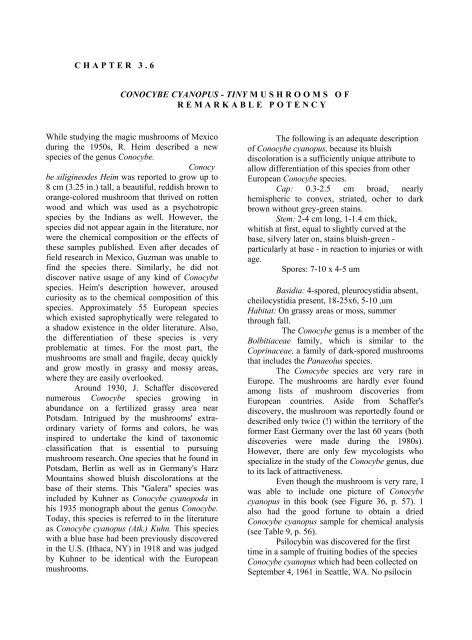Jochen Gartz - Magic Mushrooms Around the ... - preterhuman.net
Jochen Gartz - Magic Mushrooms Around the ... - preterhuman.net
Jochen Gartz - Magic Mushrooms Around the ... - preterhuman.net
Create successful ePaper yourself
Turn your PDF publications into a flip-book with our unique Google optimized e-Paper software.
CHAPTER 3.6<br />
CONOCYBE CYANOPUS - TINY M USHROOMS OF<br />
REMARKABLE POTENCY<br />
While studying <strong>the</strong> magic mushrooms of Mexico<br />
during <strong>the</strong> 1950s, R. Heim described a new<br />
species of <strong>the</strong> genus Conocybe.<br />
Conocy<br />
be siligineodes Heim was reported to grow up to<br />
8 cm (3.25 in.) tall, a beautiful, reddish brown to<br />
orange-colored mushroom that thrived on rotten<br />
wood and which was used as a psychotropic<br />
species by <strong>the</strong> Indians as well. However, <strong>the</strong><br />
species did not appear again in <strong>the</strong> literature, nor<br />
were <strong>the</strong> chemical composition or <strong>the</strong> effects of<br />
<strong>the</strong>se samples published. Even after decades of<br />
field research in Mexico, Guzman was unable to<br />
find <strong>the</strong> species <strong>the</strong>re. Similarly, he did not<br />
discover native usage of any kind of Conocybe<br />
species. Heim's description however, aroused<br />
curiosity as to <strong>the</strong> chemical composition of this<br />
species. Approximately 55 European species<br />
which existed saprophytically were relegated to<br />
a shadow existence in <strong>the</strong> older literature. Also,<br />
<strong>the</strong> differentiation of <strong>the</strong>se species is very<br />
problematic at times. For <strong>the</strong> most part, <strong>the</strong><br />
mushrooms are small and fragile, decay quickly<br />
and grow mostly in grassy and mossy areas,<br />
where <strong>the</strong>y are easily overlooked.<br />
<strong>Around</strong> 1930, J. Schaffer discovered<br />
numerous Conocybe species growing in<br />
abundance on a fertilized grassy area near<br />
Potsdam. Intrigued by <strong>the</strong> mushrooms' extraordinary<br />
variety of forms and colors, he was<br />
inspired to undertake <strong>the</strong> kind of taxonomic<br />
classification that is essential to pursuing<br />
mushroom research. One species that he found in<br />
Potsdam, Berlin as well as in Germany's Harz<br />
Mountains showed bluish discolorations at <strong>the</strong><br />
base of <strong>the</strong>ir stems. This "Galera" species was<br />
included by Kuhner as Conocybe cyanopoda in<br />
his 1935 monograph about <strong>the</strong> genus Conocybe.<br />
Today, this species is referred to in <strong>the</strong> literature<br />
as Conocybe cyanopus (Atk.) Kuhn. This species<br />
with a blue base had been previously discovered<br />
in <strong>the</strong> U.S. (Ithaca, NY) in 1918 and was judged<br />
by Kuhner to be identical with <strong>the</strong> European<br />
mushrooms.<br />
The following is an adequate description<br />
of Conocybe cyanopus, because its bluish<br />
discoloration is a sufficiently unique attribute to<br />
allow differentiation of this species from o<strong>the</strong>r<br />
European Conocybe species.<br />
Cap: 0.3-2.5 cm broad, nearly<br />
hemispheric to convex, striated, ocher to dark<br />
brown without grey-green stains.<br />
Stem: 2-4 cm long, 1-1.4 cm thick,<br />
whitish at first, equal to slightly curved at <strong>the</strong><br />
base, silvery later on, stains bluish-green -<br />
particularly at base - in reaction to injuries or with<br />
age.<br />
Spores: 7-10 x 4-5 um<br />
Basidia: 4-spored, pleurocystidia absent,<br />
cheilocystidia present, 18-25x6, 5-10 ,um<br />
Habitat: On grassy areas or moss, summer<br />
through fall.<br />
The Conocybe genus is a member of <strong>the</strong><br />
Bolbitiaceae family, which is similar to <strong>the</strong><br />
Coprinaceae, a family of dark-spored mushrooms<br />
that includes <strong>the</strong> Panaeolus species.<br />
The Conocybe species are very rare in<br />
Europe. The mushrooms are hardly ever found<br />
among lists of mushroom discoveries from<br />
European countries. Aside from Schaffer's<br />
discovery, <strong>the</strong> mushroom was reportedly found or<br />
described only twice (!) within <strong>the</strong> territory of <strong>the</strong><br />
former East Germany over <strong>the</strong> last 60 years (both<br />
discoveries were made during <strong>the</strong> 1980s).<br />
However, <strong>the</strong>re are only few mycologists who<br />
specialize in <strong>the</strong> study of <strong>the</strong> Conocybe genus, due<br />
to its lack of attractiveness.<br />
Even though <strong>the</strong> mushroom is very rare, I<br />
was able to include one picture of Conocybe<br />
cyanopus in this book (see Figure 36, p. 57). 1<br />
also had <strong>the</strong> good fortune to obtain a dried<br />
Conocybe cyanopus sample for chemical analysis<br />
(see Table 9, p. 56).<br />
Psilocybin was discovered for <strong>the</strong> first<br />
time in a sample of fruiting bodies of <strong>the</strong> species<br />
Conocybe cyanopus which had been collected on<br />
September 4, 1961 in Seattle, WA. No psilocin








![The Big Lie 9-11 and Government Complicity in Mass Murder [PDF]](https://img.yumpu.com/50957077/1/190x245/the-big-lie-9-11-and-government-complicity-in-mass-murder-pdf.jpg?quality=85)








